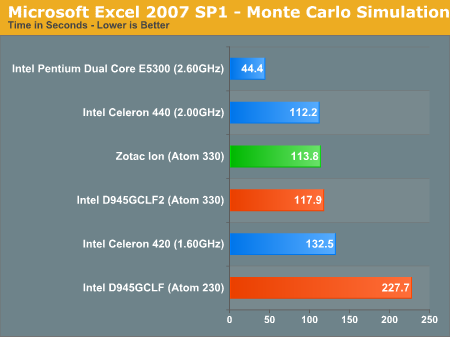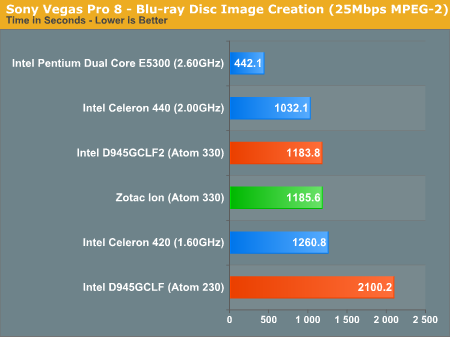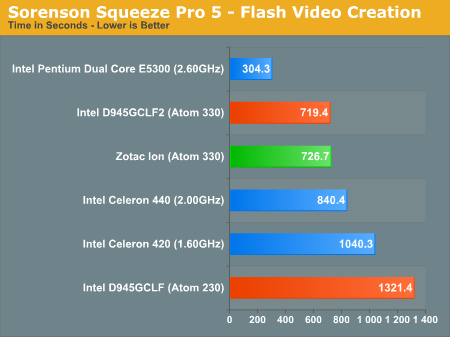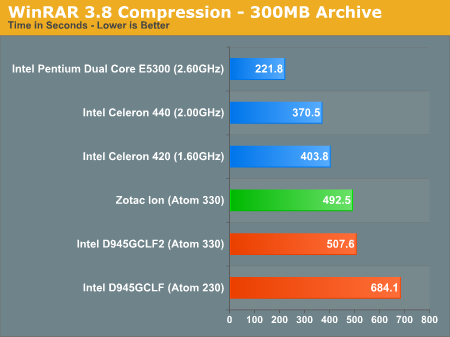Zotac's Ion: The World's First mini-ITX Ion Board
by Anand Lal Shimpi on May 12, 2009 12:00 AM EST- Posted in
- GPUs
PAR2 Multithreaded Archive Recovery Performance
Par2 is an application used for reconstructing downloaded archives. It can generate parity data from a given archive and later use it to recover the archive
Chuchusoft took the source code of par2cmdline 0.4 and parallelized it using Intel’s Threading Building Blocks 2.1. The result is a version of par2cmdline that can spawn multiple threads to repair par2 archives. For this test we took a 708MB archive, corrupted nearly 60MB of it, and used the multithreaded par2cmdline to recover it. The scores reported are the repair and recover time in seconds.

Microsoft Excel 2007
Excel can be a very powerful mathematical tool. In this benchmark we're running a Monte Carlo simulation on a very large spreadsheet of stock pricing data.

Sony Vegas Pro 8: Blu-ray Disc Creation
Although technically a test simulating the creation of a Blu-ray disc, the majority of the time in our Sony Vegas Pro benchmark is spend encoding the 25Mbps MPEG-2 video stream and not actually creating the Blu-ray disc itself.

Sorenson Squeeze: FLV Creation
Another video related benchmark, we're using Sorenson Squeeze to convert regular videos into Flash videos for use on websites.

WinRAR - Archive Creation
Our WinRAR test simply takes 300MB of files and compresses them into a single RAR archive using the application's default settings. We're not doing anything exotic here, just looking at the impact of CPU performance on creating an archive:











93 Comments
View All Comments
KidneyBean - Tuesday, May 12, 2009 - link
Isn't it stealing to use Media Player Classic if you use patented decoders without paying for them?If so, I would hope you don't publish such information in articles in the future.
Penti - Friday, May 29, 2009 - link
Nope infringement is never steeling. It's pretty okay as long as it isn't used commercially. Usually your allowed to use any patents for personal use though. So it's fine. You won't go to jail. Of course he won't publish stuff that discourage the use of homebrew codecs and software that are needed for playing warez and illegally ripping your movies. It would be silly as that's what people use computers for, especially htpcs. It would really be a limited worthless device without it.sprockkets - Tuesday, May 12, 2009 - link
With MPEG4, you only pay what you publish with it, not decode.DXA for nvidia cards is clearly documented on how to use it.
Dolby Digital is another story, but seeing as how you can send the bitstream to your receiver to decode it legally, what's the big deal?
Jeffk464 - Tuesday, May 12, 2009 - link
I don't understand what the major need is to have a low power desktop. If it plugs into the wall its not really an issue like it is with notebooks. Its seems like the main focus for a Home Theater PC should be in keeping things quiet. Why not use a notebook processor and focus on making a super quiet heat sink and fan. I like the idea of compact pc's but HP has managed to squeeze a full on systems with a high end cpu onto the back of a lcd display in a nice little package.cosmotic - Tuesday, May 12, 2009 - link
How are Flash (normal animation and (HD)video) and Java graphics performance?For Java, you can install the JDK and double click the jar:
C:\Program Files\Java\jdk1.6.0_13\demo\jfc\Java2D\Java2Demo.jar
The composite and transform demos would be particularly helpful.
Anand Lal Shimpi - Tuesday, May 12, 2009 - link
I've been meaning to talk about FLV performance, I'll try and include that in a short followup soon.Take care,
Anand
strikeback03 - Tuesday, May 12, 2009 - link
The version of the Intel LF2 board you have here is already being pulled from the channel. It's replacement is the LF2D, which loses the S-Video port. Not a huge loss, as most people who tried to use it could not get what they wanted out of it (does not support different content to both the VGA and S-Video ports).Was Vista the OS for all the tests? I am using an LF2 board in my carputer with 1GB RAM, running a somewhat stripped-down version of XP on a 7200RPM 2.5" drive. Running on the car touchscreen (7", 800x480) or in PIP on my desktop monitor, and it feels pretty snappy in general usage. If I give it the full 1920x1200 though it slows down a lot, especially in my front-end software. Also, the image quality over VGA is not as good as some laptops I have hooked up to that monitor over VGA.
For carputer use I would like to see a better onboard audio codec and more ports. The 3-port thing doesn't give much flexibility on inputs and outputs.
Is the increased power consumption of the Intel boards due to using a standard ATX PSU? Did you consider getting one of the Pico-PSUs (like this: http://www.mini-box.com/picoPSU-150-XT-102-power-k...">http://www.mini-box.com/picoPSU-150-XT-102-power-k... ) to try on a more comparable basis? Also, is there any way to test the draw on each rail? The Intel boards are not really compatible with the lower-powered Pico-PSUs due to rather excessive draw on the 5V rail.
Anand Lal Shimpi - Tuesday, May 12, 2009 - link
Vista was the OS used for all of the tests and I'll second what you're saying, I've found XP far snappier than Vista with these Atom based systems. I just stuck with Vista to keep the results somewhat comparable to other CPU results.I did use a standard ATX power supply on the Intel boards but that's why I also tossed in the Eee Box results to show you what an Atom system with a smaller PSU can do.
Take care,
Anand
Jeffk464 - Tuesday, May 12, 2009 - link
I don't understand what the major need is to have a low power desktop. If it plugs into the wall its not really an issue like it is with notebooks. Its seems like the main focus for a Home Theater PC should be in keeping things quiet. Why not use a notebook processor and focus on making a super quiet heat sink and fan. I like the idea of compact pc's but HP has managed to squeeze a full on systems with a high end cpu onto the back of a lcd display in a nice little package.sprockkets - Tuesday, May 12, 2009 - link
Look at the prices on logic supply for a laptop socket itx board and how much the processor is and you will see how much cheaper this setup is.Besides, the vast majority of Anandtech readers prefer to build ourselves, not buy OEM crap.